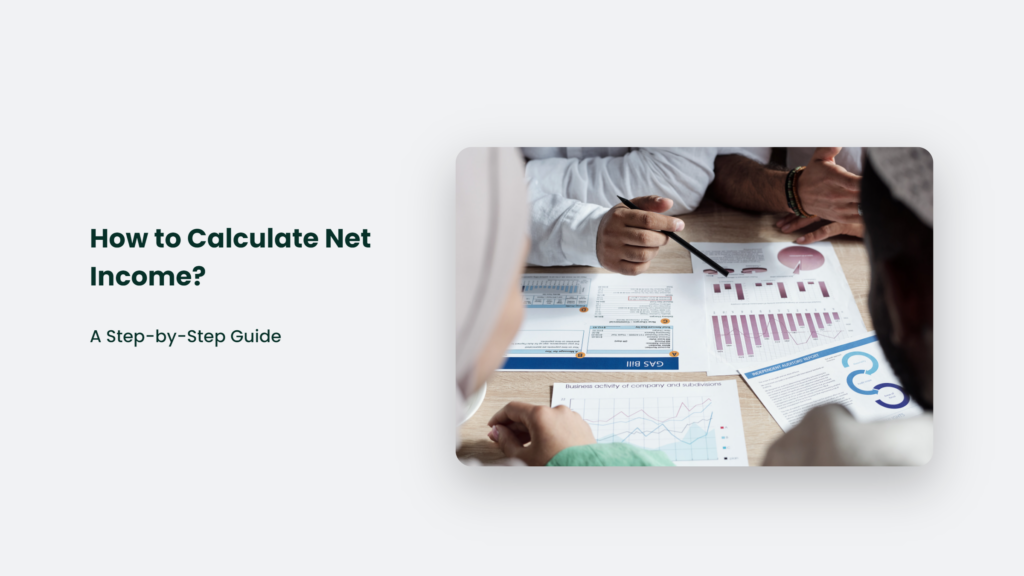

How to Calculate Net Income? A Step-by-Step Guide

As Seen On
Let’s cut the crap and get right to it – calculating net income is a pain in the ass. As a business owner, you’ve got a million things to worry about. Do I really need to become an accountant on top of everything else?
The answer is yes… and no.
No, you don’t need to go back to school and get a degree in accounting. But yes, you do need to understand some basic accounting principles if you want your business to survive and thrive.
Net income – also known as net profit or the bottom line – is a critical number every business owner should know. It tells you how much money your business actually earned after subtracting all expenses.
So, wondering how to calculate net income. I’ll explain in simple terms that even a fifth-grader could understand.

How to Calculate Net Income:
Step 1: Calculate Your Revenue
Revenue is all the money that comes into your business from sales, services, interest, or other sources.
For example, if you sold $100,000 worth of products and services, your revenue is $100,000. Simple enough so far.
Step 2: Subtract the Cost of Goods Sold
Cost of goods sold (COGS) includes all the direct costs involved in producing your products or delivering your services.
It includes:
- Raw materials
- Packaging costs
- Shipping costs
- Direct labor
Let’s say it costs you $40,000 to manufacture or purchase the products you sold for that $100,000 in revenue. Your COGS would be $40,000.So now you take your $100,000 in revenue and subtract the $40,000 in COGS to get your gross profit of $60,000.
Step 3: Subtract Operating Expenses
Operating expenses are all the overhead costs needed to run your business day-to-day.
It includes:
- Rent
- Utilities
- Payroll
- Insurance
- Office Supplies
- Legal and accounting fees
- Advertising
- Repairs and maintenance
- Travel
- Meals and entertainment
Let’s say your operating expenses last month totalled $30,000. Now, you take your $60,000 gross profit and subtract the $30,000 in operating expenses to get your operating income of $30,000.
Step 4: Subtract Non-Operating Expenses
Non-operating expenses are costs not directly related to the core operations of your business. It includes:
- Interest paid on business loans
- Losses from selling assets
- Fines and legal settlements
If you had $5,000 in non-operating expenses, you would subtract that from the $30,000 operating income to get $25,000.
Step 5: Subtract Taxes
The final step is to subtract taxes. It includes the income tax you owe on the profit your business earned.
Suppose your tax rate is 25%, and you owe $6,250 (25% of $25,000) in taxes.
Subtract the $6,250 from $25,000, and you get your net income of $18,750.That’s it! That’s how you calculate your net income.
To summarise:
Revenue
- Cost of Goods Sold = Gross Profit
Gross Profit
- Operating Expenses = Operating Income
Operating Income
- Non-Operating Expenses = Pre-Tax Income
Pre-Tax Income
- Taxes= Net Income
See, I told you this shit wasn’t that hard. With some basic math skills and a few simple steps, you can calculate this critical number for your business.
Knowing your net income allows you to:
- Evaluate the profitability and health of your business
- Compare income over different time periods
- Determine if you can afford to hire more staff or invest in growth
- Decide if you can pay yourself or give owners a distribution
- Calculate important ratios like profit margin
So take the time each month to calculate it accurately. Your future self will thank you.
What is the Difference Between Net Income and Cash Flow?
I know you’re dying to ask this next question. What’s the difference between net income and cash flow?
Great question. I like your style.
Net income is an accounting profit based on the accrual method of accounting. Accrual accounting means you count revenue when it’s earned and expenses when they’re incurred.
But cash flow is the actual cash moving in and out of your business.
Your net income may be high one month, but you could still have negative cash flow if you aren’t collecting customer payments.
Likewise, you could have a loss on paper but still be flush with cash.
So, monitor both net income and cash flow to assess the real financial health of your business. Net income evaluates profitability, and cash flow evaluates liquidity.
How to Calculate Net Income in 5 Easy Steps?
Let’s walk through a simple example together.
Pretend you own a bakery called Delicious AF Treats. Here are your numbers for last month:
Revenue:
Cupcake sales: $50,000 + Cookie sales: $30,000
Total revenue = $80,000
Expenses:
Cost of ingredients (COGS): $20,000 + Rent: $5,000 + Wages: $15,000 + Utilities: $1,000+ Advertising: $2,000 + Credit card fees: $500
Total expenses (Operating Expenses) = $43,500
Taxes:
You pay a flat income tax rate of 20%
So here are the 5 steps to calculate your net income:
- Revenue = $80,000
- COGS = $20,000
- Gross profit = Revenue – COGS = $80,000 – $20,000 = $60,000
- Operating expenses = $43,500
Net income = Gross profit – Operating expenses – Taxes
= $60,000 – $43,500 – 20% of $60,000
= $60,000 – $43,500 – $12,000
= $4,500
Your net income for the month is $4,500.
See? With just a few basic steps, you can quickly calculate this vital metric.
Knowing your net income allows you to make smart business decisions and set your business up for success.
So grab your financial statements and get calculating! Understanding the profitability of your business is one of the most important things you can do as a business owner.
The Bottom Line:
Calculating net income is a critical skill for any business owner. It allows you to assess profitability, monitor financial health, and make smart strategic decisions.
While the formula may seem complicated at first, it’s actually pretty straightforward with just 5 steps:
- Revenue
- Subtract COGS
- Subtract operating expenses
- Subtract non-operating expenses
- Subtract taxes
The result is your net income or net profit. It is a number you should calculate regularly and use to guide your business strategy.
So grab your financials and get number crunching! Knowing your net income will empower you to take your business to the next level.
Konger
Up until working with Casey, we had only had poor to mediocre experiences outsourcing work to agencies. Casey & the team at CJ&CO are the exception to the rule.
Communication was beyond great, his understanding of our vision was phenomenal, and instead of needing babysitting like the other agencies we worked with, he was not only completely dependable but also gave us sound suggestions on how to get better results, at the risk of us not needing him for the initial job we requested (absolute gem).
This has truly been the first time we worked with someone outside of our business that quickly grasped our vision, and that I could completely forget about and would still deliver above expectations.
I honestly can't wait to work in many more projects together!
Disclaimer
*The information this blog provides is for general informational purposes only and is not intended as financial or professional advice. The information may not reflect current developments and may be changed or updated without notice. Any opinions expressed on this blog are the author’s own and do not necessarily reflect the views of the author’s employer or any other organization. You should not act or rely on any information contained in this blog without first seeking the advice of a professional. No representation or warranty, express or implied, is made as to the accuracy or completeness of the information contained in this blog. The author and affiliated parties assume no liability for any errors or omissions.

